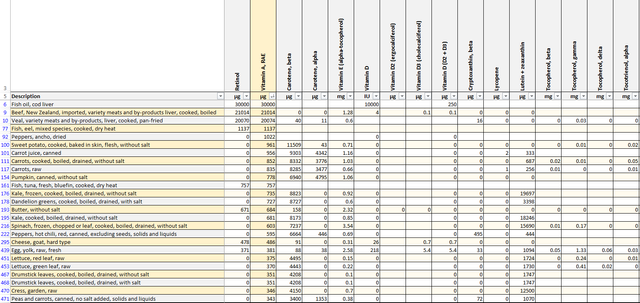Vitamin A – Top Food Sources, Recommended Intake/RDA, and the Dangers & Side Effects of Overconsumption
Read the original article on foodosage.com
What we call Vitamin A is actually a group of so called retinoids. (Retinol, retinal, and retinyl esters). Retinal in particular is critically important for maintaining normal vision. They are also needed for gene expression, reproduction, embryonic development, immune function, cell growth and differentiation and the maintenance of the lungs, kidney, and heart, among other organs.
Vitamin A comes in two main forms:
Provitamin A Carotenoids: Plant pigments, which are metabolized into the active forms of Vitamin A: Retinal and retinoic acid. The most important carotenoid (for us) beta-carotine, followed by the far less relevant alpha-carotene and beta-cryptoxanthin. The other forms (lycopene, lutein, and zeaxanthin) are not converted by our bodies.
Preformed Vitamin A (retinol & retinyl ester): Found in animal sources. Basically, the already converted provitamins. These are essential for pure carnivores such as cats, which lack the ability to process carotenoids.
This article will cover the recommended intake levels, why we want to reach those levels, the dangers of overconsumption, and which foods are richest in Vitamin A.
Note that all recommended intake figures below are based on the needs of a 31 year old non-pregnant, non-lactating woman on a 2000 kilocalorie diet. Your personal requirements may differ (wildly). One way to figure out your individual needs, including calories per day, is the FooDosage Nutrition Calculator. It's free, by the way.
Recommended Vitamin A Intake
The recommended intake range for Vitamin A, as set by the National Academy of Sciences:
Recommended minimum Intake (RDA): 700 µg per day
Upper limit: 3000 µg per day.
Note that your personal requirements may differ depending on your age and sex. Lactating women in particular require higher amounts (1200-1300 µg).
Importance of an Adequate Vitamin A Intake (Dangers of a Deficiency)
As mentioned, Vitamin A has many functions in our bodies, including gene expression, reproduction, embryonic development, immune function, and cell growth. But its main function, and the one it's most famous for is maintaining normal vision.
Side note: Vitamin A (and carrots) does not improve vision. It maintains normal vision. The corresponding myth was invented by the Royal Airforce as part of a confusion-propaganda campaign against the Germans. I'm sorry, but eating lots of carrots will not improve your eyesight, "just" help keep it at its current level.As such, one of the greatest dangers of a Vitamin A deficiency is loss of vision, via xerophthalmia. Other dangers include an increased risk of diarrhea, as well as an increased severity and mortality of infections.
While severe Vitamin A deficiency is rare in developed countries, pregnant and lactating women should be especially careful to meet the minimum requirements, as adequate Vitamin A levels are necessary for normal fetal and child development.
Risks of an Excessive Vitamin A Consumption (Side Effects)
Being a fat soluble vitamin, respecting the upper limit for Vitamin A is more important than with water soluble ones, as excess amounts are stored in the liver, and cannot be disposed of as quickly. Liver toxicity is a main danger of Vitamin A overconsumption. Note, however, that this is only an issue for preformed Vitamin A. Carotenoids have not shown to cause these issues. Instead, an overdose of beta-carotene may give your skin an orange hue, but this is an aesthetic side effect.
Additionally to all the side effects associated with liver toxicity, consuming excessive amounts of Vitamin A has been associated with teratological effects on fetal development (growth retardation, delayed mental development or other congenital disorders), and osteoporosis (bone brittleness).
Special Considerations
Individuals with high alcohol intake, preexisting liver disease, hyperlipidemia or severe protein malnutrition may be distinctly susceptible to the adverse effects of excess preformed Vitamin A intake. Beta-carotene supplements are advised only to serve as a provitamin A source for individuals at risk of vitamin A deficiency.
Top Vitamin A Food Sources
The highest concentrations of Vitamin A are generally found in liver, dairy products, fish, darkly colored fruits, and leafy vegetables.
Some choice examples of Vitamin A rich foods:
 Vitamin A Leaderboard - FooDosage Nutrition Calculator
Vitamin A Leaderboard - FooDosage Nutrition Calculator
.
.
.
Read the full article on foodosage.com
.
.
.
Bon Appetit :-)
Sources:
http://www.nationalacademies.org/hmd/Activities/Nutrition/SummaryDRIs/DRI-Tables.aspx
https://ods.od.nih.gov/factsheets/VitaminA-HealthProfessional/